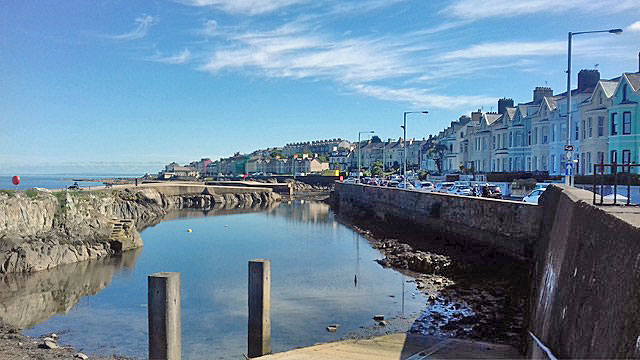A very recent planning application seeks to make the biggest change to this Bangor feature in its history … other perhaps than the concrete surfacing laid for vehicle owners accessing their boats in the 1950s! As part of a major upgrade to the whole coastal path, a bridge for walkers and cyclists will connect the end of the Long Hole to Seacliff Road!
The Long Hole has lain empty of boats since the safer haven of the marina was completed 30 years ago. What could be done with it? (An option to fill it in for car-parking as part of the marina scheme had been ‘leaked’ and met with outraged opposition from many Bangorians!) There was some talk years later of gates to maintain a level and use as a water-sports venue. But the new concept is the first tangible change.
What are the origins of this pretty attraction in that odd place ‘Old Bangor’ (which rather depends on how old you are yourself)? It is certainly man-made. There’s a choice between two legends: that the excavated stone was used for the wall surrounding the Castle estate; or that it was used for a mole or breakwater across Bangor Bay, an early version of the Eisenhower Pier. It appears much as today on the first Ordnance Survey map, 1834. Landlords around the 1820s and 30s, it is said, became enamoured with the use of gunpowder to improve their estates.

The gentlemen in the photo are Captain William Coey and Alex Yeoman. It is one from North Down Museum's Savage Collection and was taken by James Savage c.1891.
This is the time of the rather mysterious ‘coach road’ round Orlock Point – still clearly visible today - which was a quixotic venture of Mr. Ker of Portavo, complete with bridges or causeways over inlets, long collapsed, and the arch through solid rock, still there to walk through! So quite possibly his neighbour Mr. Ward of Bangor Castle was commissioning a similar contract, blasting rock. Maybe the alternative name – now pretty much died out – the ‘Big Hole’ is a plausible reaction on the part of the locals of the day! That’s what was left – a big hole. You can imagine the locals exclaiming that when the dust settled : ‘the big hole! ‘
A completely implausible theory was proffered, though, by a Spectator correspondent in 1949, responding to a proposal (the one resurrected in the 1980s) to convert it to a car park The well-meaning Antiquary claimed that the Long Hole existed in the time of Saint Columbanus and that he and Saint Gall had set off from this very haven on their missionary voyages to heathen Europe. Later, he states, the Vikings landed here on a much less peaceful enterprise. Grandly, he concludes:
‘ … there are few sea coves the world over more interwoven with world events than this one, and to end as a car park seems an inadequate fate for such a spot’.
I hope Antiquary was still around in 1985! He (or she) would have been delighted that North Down Borough Council sent a very large stone washed by the sea on the outer side of the Long Hole to Bregenz at their request, at the outset of the twinning arrangement. It still stands with a suitable plaque outside a church. (I was involved in the negotiations, including several phone calls with a very pleasant and enthusiastic Austrian lady in Bregenz, who spoke perfect English – the only word she didn’t understand was ‘barnacles’!)
Astonishingly, the two paddle steamers that operated to Belfast in the 1880s and 90s would be squeezed in for the winter to the Long Hole, the Erin and the Bangor Castle. But for many decades, as innumerable postcards depict, the Long Hole was a haven for local inshore fishing and pleasure boats. Now we await a new chapter, after nearly 200 years – and not as a car park!

The Long Hole in 2020
